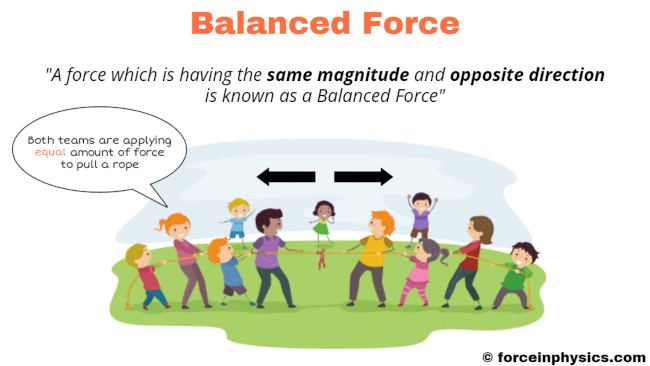
A balanced force describes a scenario where forces acting on an object are equal in magnitude but act in opposite directions. This balance between the forces leads to a state of stability, where the object remains motionless or maintains constant velocity. An excellent example that demonstrates balanced forces is the game of tug of war. In this game, two teams exert equal amounts of force in opposite directions on a rope. As a result, the rope remains stationary, showcasing the equilibrium created by the balanced forces.
Examples
Standing
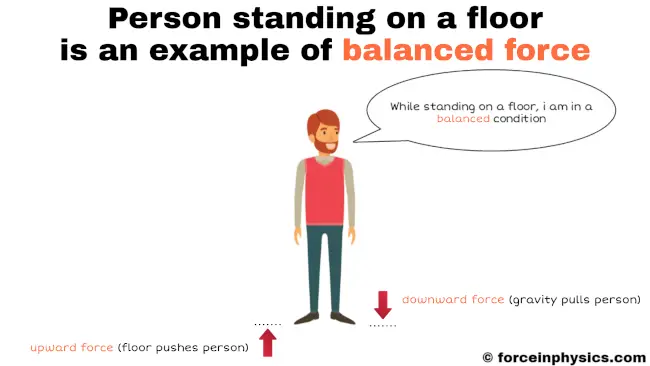
When an individual stands on the floor, it is an example of a balanced force. The force of gravity pulls the person downward towards the center of the Earth, while the floor exerts an equal and opposite force known as the normal force. The normal force counteracts the force of gravity and pushes upward on the person with the same magnitude. As a result, the individual remains in a state of equilibrium, neither sinking into the floor nor rising into the air. The balanced force ensures that the person can stand stably on the floor without any noticeable upward or downward motion.
Computer
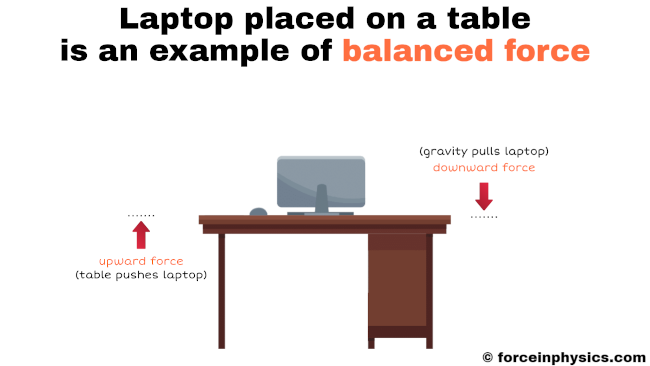
When a computer is placed on a table, it represents a balanced force situation. The force of gravity pulls the computer downward towards the center of the Earth, while the table exerts an equal and opposite force, known as the normal force. The normal force supports the weight of the computer and prevents it from falling through the table. As a result, the computer remains in a state of equilibrium, with no net force acting on it. This balanced force enables the computer to rest steadily on the table’s surface without any noticeable movement.
Sitting
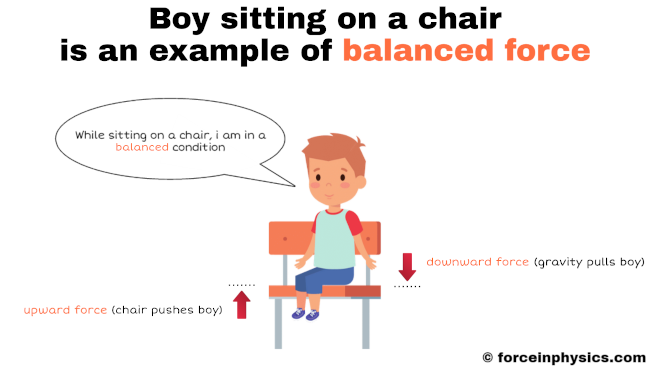
When a boy sits on a chair, the forces are balanced. The force of gravity pulls the boy downward towards the Earth, while the chair exerts an equal and opposite force, known as the normal force, in the upward direction. These balanced forces create a state of equilibrium and allow the boy to remain comfortably seated on the chair without any noticeable movement. The chair’s normal force effectively counters the gravitational force and prevents the boy from falling through the chair or experiencing an upward motion. As a result, the boy can sit securely and peacefully on the chair.
Book
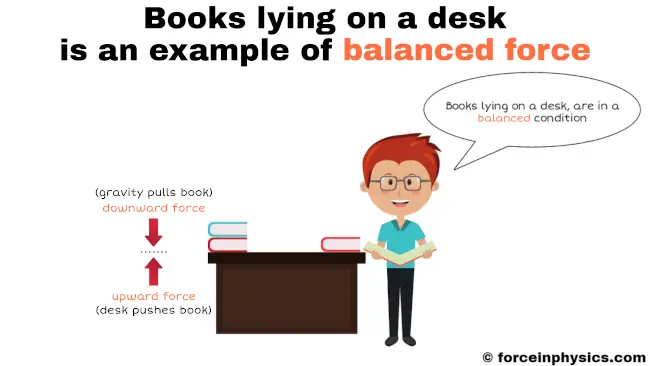
The presence of balanced forces is evident when a book is resting on a desk. The force of gravity pulls the book downward towards the desk’s surface, while an equal and opposite upward force, known as the normal force, is exerted by the desk on the book. These balanced forces interact, resulting in a state of equilibrium, where the book remains motionless on the desk. The gravitational force is precisely balanced by the normal force, preventing the book from sinking through the desk or levitating above it. Thus, the book’s stable position on the desk exemplifies the concept of balanced force.
Ceiling fan
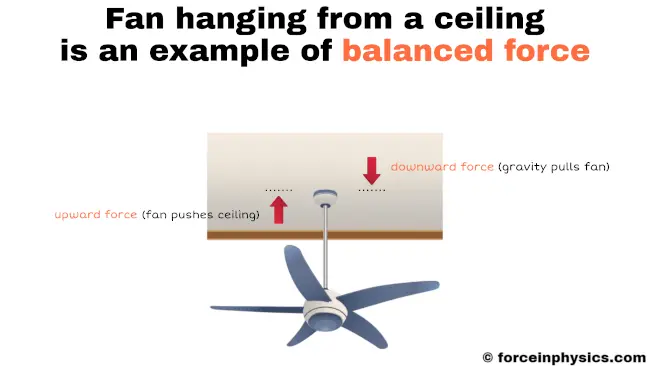
When a ceiling fan is hanging with a metal rod, it is an illustration of balanced forces. The fan experiences an equal and opposite force of gravity pulling it downward and a supporting force, the tension in the metal rod, acting in the upward direction. These opposing forces are in perfect equilibrium, keeping the ceiling fan suspended in its position. As a result, the fan remains steady and motionless, showcasing the concept of balanced force at work.
Light fixture
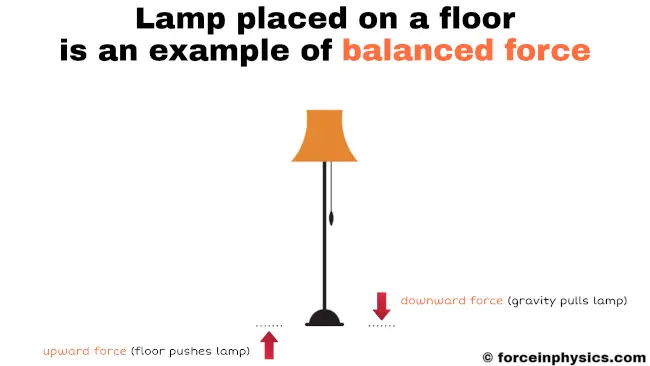
When a light fixture, such as a night lamp, is placed on a flat surface, it exemplifies the concept of balanced force. The flat surface exerts an upward force on the lamp, supporting its weight and preventing it from sinking into the surface. Simultaneously, gravity exerts a downward force on the lamp, attempting to pull it toward the ground. These two forces, the upward force from the surface and the downward force of gravity, are equal in magnitude and opposite in direction, resulting in a state of equilibrium. As a consequence, the light fixture remains in a stable and steady position on the flat surface, illustrating the principle of balanced force at play.
Hanging cloth

When a cloth is hung on a metal rod through a hanger, it experiences a balanced force. The force exerted by the hanger in an upward direction counteracts the force of gravity pulling the cloth downward. These two opposing forces are equal in magnitude and opposite in direction, resulting in a state of equilibrium. The cloth remains in a stable position and does not fall or move because the balanced forces cancel each other out.
Fruit

When a fruit hangs from a tree branch, it experiences a balanced force that keeps it stationary. The tree branch exerts an upward force on the fruit, supports its weight, and prevents it from falling to the ground. At the same time, gravity pulls the fruit downward, trying to make it drop. However, the upward force from the branch and the downward force of gravity are equal in magnitude and opposite in direction, which creates a balanced force. As a result, the fruit remains in its position without any movement or acceleration. This state of equilibrium, where the forces acting on the fruit cancel each other out, exemplifies the concept of balanced force in action, keeping the fruit hanging safely on the tree branch.
Motorcycle

When a motorcycle is parked on the road, it exemplifies a balanced force scenario. The motorcycle experiences two equal and opposite forces: an upward force from the road surface, which provides support and resistance against gravity’s pull. Gravity, on the other hand, exerts a downward force and attempts to make the motorcycle fall. These two forces, with equal magnitudes and opposite directions, counterbalance each other, resulting in a state of equilibrium. As a result, the motorcycle remains stationary on the road, a demonstration of the concept of balanced force at work.
Ball
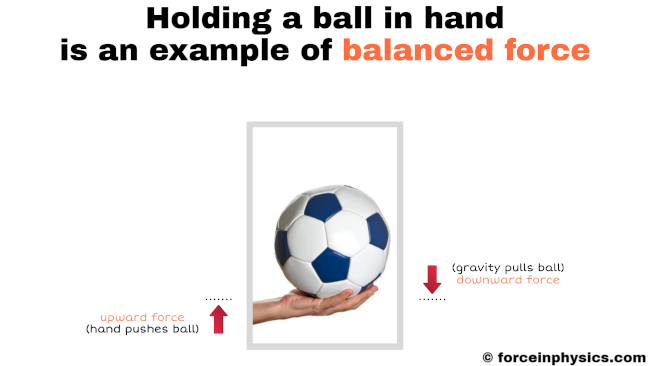
When a ball is placed on a hand, it showcases an example of balanced force. The hand exerts an upward force known as the normal force, supporting the weight of the ball. Simultaneously, gravity pulls the ball downward with an equal and opposite force. These two forces, with identical magnitudes but opposing directions, create a state of balance. As a result, the ball remains motionless on the hand, demonstrating the concept of balanced force. The equilibrium between the upward normal force and the downward force of gravity prevents the ball from accelerating in any direction and keeps it steadily in place on the hand.
Stone

When a large stone rests on the ground, it serves as an example of balanced force. The stone experiences two opposing forces: an upward force exerted by the ground, known as the normal force, and the downward force of gravity. These forces are equal in magnitude but act in opposite directions, which establishes a state of equilibrium. As a result, the stone remains stably in place, illustrating the concept of balanced force. The equilibrium between the upward normal force and the downward force of gravity prevents the stone from accelerating or moving and allows it to rest peacefully on the ground.
Sleeping
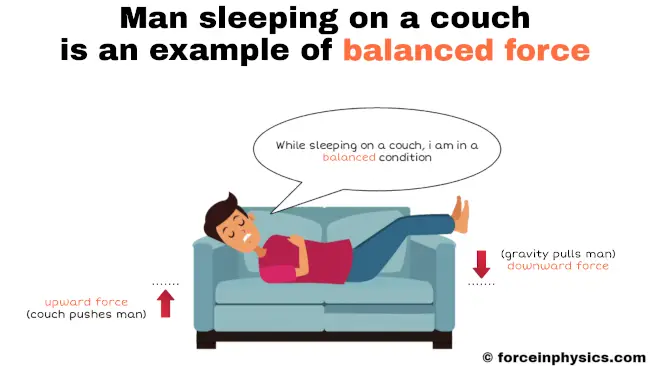
When an individual is sleeping on a sofa, the concept of balanced force comes into play to ensure stability and comfort. In this scenario, two forces act on the person: gravity pulls them downward, and the sofa exerts an upward force known as the normal force. These two forces are equal in magnitude but act in opposite directions, leading to a state of equilibrium. As a result, the person remains comfortably and motionlessly supported on the sofa. The balanced force allows the individual to enjoy a restful sleep without experiencing any noticeable movement or acceleration.
Related
- Balanced force
- Unbalanced force
- Friction
- Tension (physics)
- Applied force
- Normal force
- Drag (physics)
- Gravity
- Centripetal force
- Centrifugal force
- Buoyancy
- Net force
- Compression (physics)
More topics
External links
- Balanced and unbalanced forces – California State University, Northridge
- Balanced vs. Unbalanced Forces – The Physics Classroom
- What Are Balanced and Unbalanced Forces? – Roma Independent School District
- Balanced & Unbalanced Forces Video For Kids – Generation Genius
- Balanced vs. Unbalanced Force | Definition & Examples – Study.com
- Balanced Force: Definition, Examples, and Equation – Science Facts
- Motion: Balanced and Unbalanced Forces – Turito
- What are Balanced Forces? 5 Brilliant Examples of Balanced Forces – Earth Eclipse
- Investigate how balanced forces affect an object’s motion – Varsity Tutors
- Balanced Forces – DK Find Out!
- Balanced Forces – Weebly
- Balanced and unbalanced forces – BBC
- What Is Balanced Force – TutorOcean
- Balanced and Unbalanced Forces – TeachPE.com
- Examples of balanced forces – PhysicsGoEasy
- What’s an example of balanced force? – Quora
- What Happens When Forces Are Balanced or Unbalanced? – Woodstown-Pilesgrove Regional School District
- What are Balanced and Unbalanced Forces? A Guide for Young Scientists – Science Times
- Balanced Forces and Unbalanced Forces – Experiment – Vernier
- Balanced Force Calculator – Calculator Academy
Deep
Forceinphysics.com was founded by Deep Rana, who is a mechanical engineer by profession and a blogger by passion. He has a good conceptual knowledge on different educational topics and he provides the same on this website. He loves to learn something new everyday and believes that the best utilization of free time is developing a new skill.
